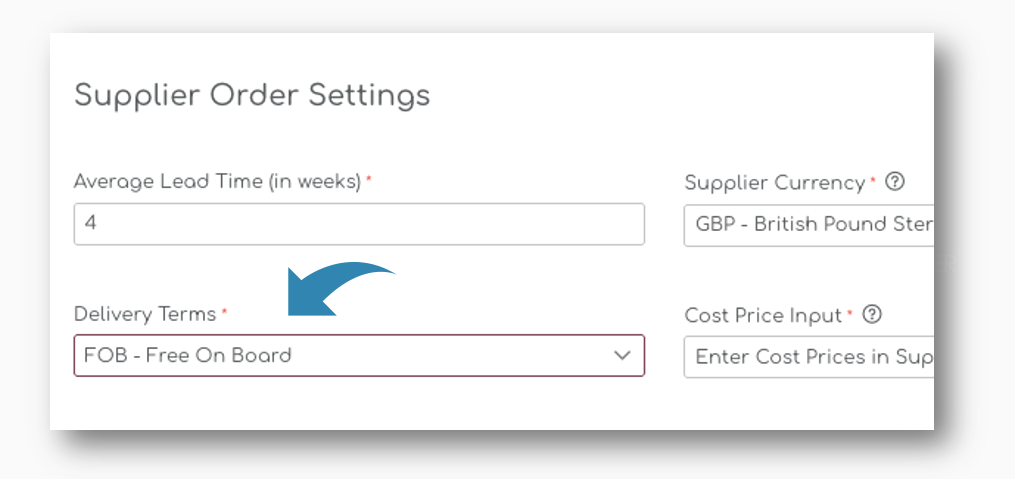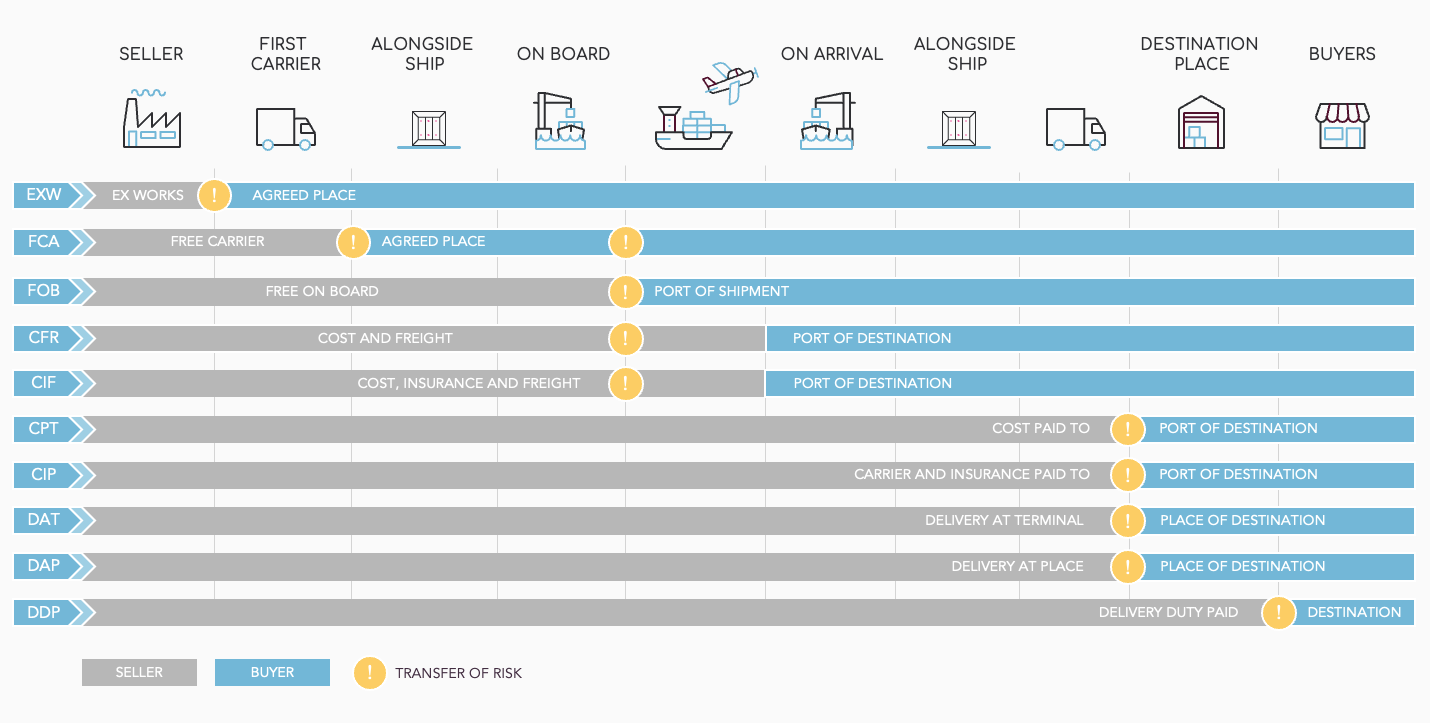Delivery Terms
Understanding and utilising delivery terms effectively is crucial for managing logistics and supply chains, especially for small to mid-sized companies. These terms define the responsibilities and risks between you as the buyer and the seller during the transportation of goods.
By choosing the appropriate delivery term, you can streamline transactions and maintain better control over your shipments. Below are explanations for each delivery term, tailored to your role with practical examples to illustrate their application.
Set Delivery Terms in Shelf Planner
Delivery Terms by Supplier
When you create a supplier in the app, one of the fields you are asked to provide is the Delivery Terms:

Delivery Terms by PO
At the moment, you can only set an incoterm or delivery term per supplier, but we have new feature in the pipeline where you can define the Delivery Term at a PO level.
Delivery Terms Explained
We use most of the standard Delivery Terms in the industry and even thought it is not a mandatory field, it can be helpful to make sure you have the right agreements with your suppliers.
The possible Delivery Terms are:
- Ex Works (EXW)
- Free Carrier (FCA)
- Carriage Paid To (CPT)
- Carriage and Insurance Paid To (CIP)
- Delivered at Terminal (DAT)
- Delivered at Place (DAP)
- Delivered Duty Paid (DDP)
- Cost and Freight (CFR)
- Cost, Insurance and Freight (CIF)

EXW (Ex Works)
- Explanation: You are responsible for all transportation costs and risks from the seller's premises.
- Transfer of Risk: At the seller's premises.
- Costs Borne By: You bear all costs from the seller's premises.
FCA (Free Carrier)
- Explanation: You deliver the goods to a carrier at a specified location.
- Transfer of Risk: When the goods are delivered to the carrier at the agreed place.
- Costs Borne By: You bear costs up to the delivery to the carrier; the buyer bears the rest.
FOB (Free On Board)
- Explanation: You deliver the goods on board the vessel nominated by you at the named port of shipment.
- Transfer of Risk: When the goods are on board the vessel.
- Costs Borne By: You bear costs up to the point of loading on the vessel; the buyer bears the rest.
CFR (Cost and Freight)
- Explanation: You pay for the transport of goods to a named port of destination.
- Transfer of Risk: When the goods are on board the vessel.
- Costs Borne By: You bear the cost of transport to the port of destination; the buyer bears the risk during transit.
CIF (Cost, Insurance and Freight)
- Explanation: You manage transport, insurance, and delivery to a specific port.
- Transfer of Risk: When the goods are on board the vessel.
- Costs Borne By: You bear the cost of transport and insurance to the port of destination; the buyer bears the risk during transit.
CPT (Carriage Paid To)
- Explanation: You pay for transporting the goods to a named destination.
- Transfer of Risk: When the goods are handed over to the first carrier.
- Costs Borne By: You bear the cost of transport to the named destination; the buyer bears the risk during transit.
CIP (Carriage and Insurance Paid To)
- Explanation: You handle transport and insurance to a specific destination.
- Transfer of Risk: When the goods are handed over to the first carrier.
- Costs Borne By: You bear the cost of transport and insurance to the named destination; the buyer bears the risk during transit.
DAT (Delivered at Terminal)
- Explanation: You deliver the goods to a terminal at the agreed port or destination.
- Transfer of Risk: When the goods are unloaded at the terminal.
- Costs Borne By: You bear all costs to the terminal; the buyer bears the costs after unloading.
DAP (Delivered at Place)
- Explanation: You deliver the goods to a specified location, ready for unloading by the buyer.
- Transfer of Risk: When the goods are available for unloading at the named place.
- Costs Borne By: You bear all costs to the named place; the buyer bears unloading costs.
DDP (Delivered Duty Paid)
- Explanation: You handle everything, including import duties and taxes, for delivery to the buyer’s location.
- Transfer of Risk: When the goods are available for unloading at the destination.
- Costs Borne By: You bear all costs, including duties and taxes, to the destination.
Why use Delivery Terms
Delivery terms, also known as Incoterms (International Commercial Terms), are standardised trade terms used worldwide to define the responsibilities and risks between buyers and sellers in international and domestic transactions. These terms specify who is responsible for different aspects of the shipping process, including transportation, insurance, and customs duties.
Among these, some terms are more commonly used across various industries due to their flexibility and clarity:
- FOB (Free On Board): Widely used in maritime shipments, where the seller is responsible until the goods are loaded on the ship.
- CIF (Cost, Insurance, and Freight): Popular for international shipments where the seller handles transport and insurance to the destination port.
- EXW (Ex Works): Commonly used when the buyer wants to control the entire shipping process from the seller's premises.
- DAP (Delivered at Place): Frequently used in various industries as it places responsibility on the seller until the goods are delivered to the buyer’s location, ready for unloading.
